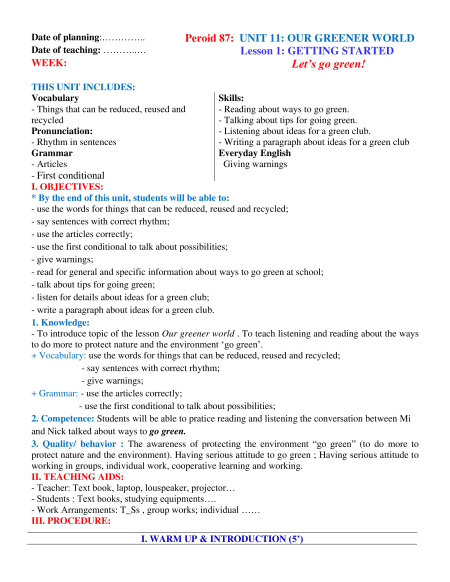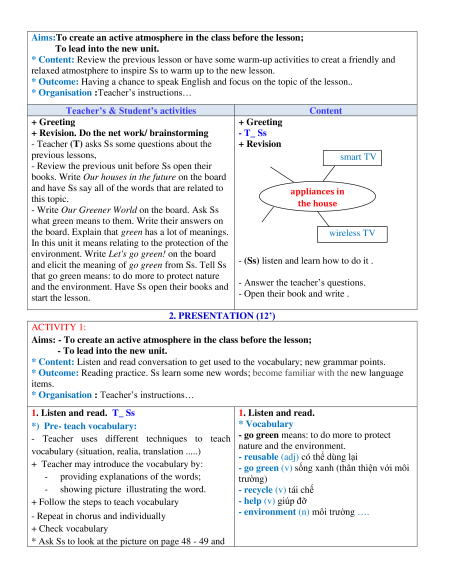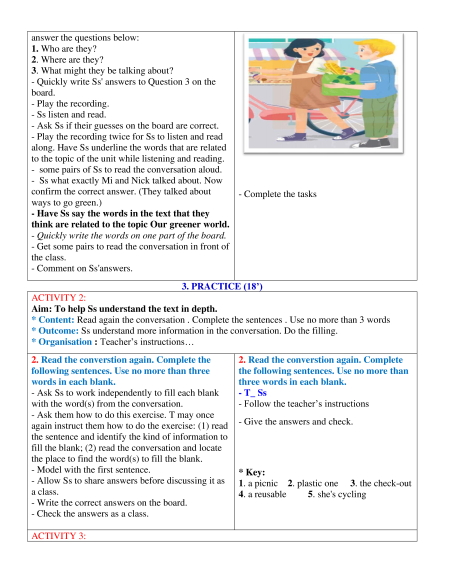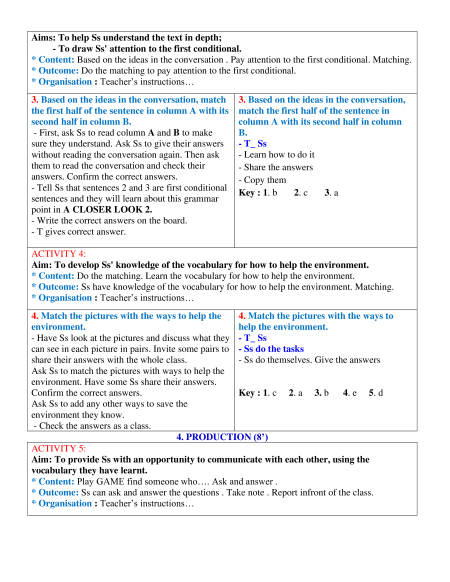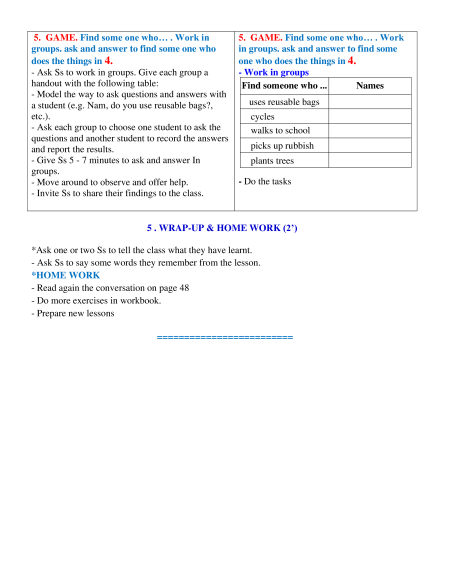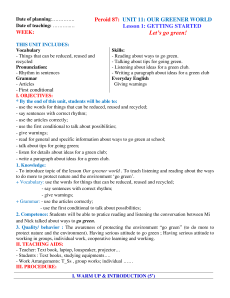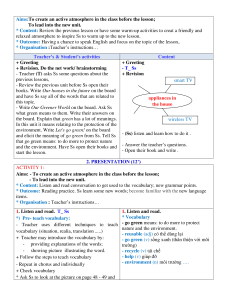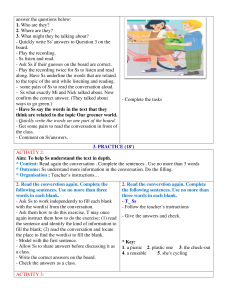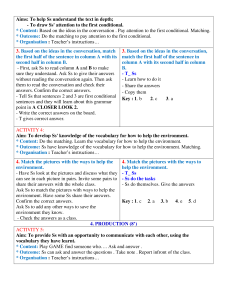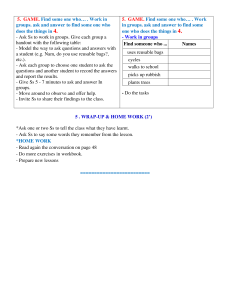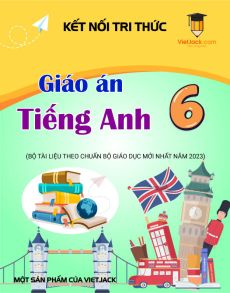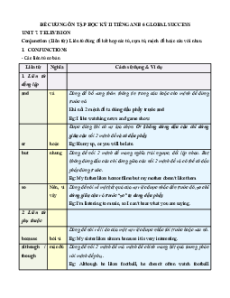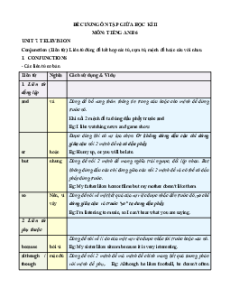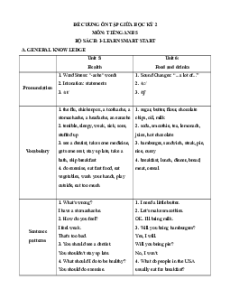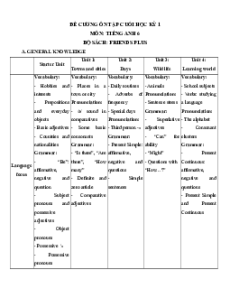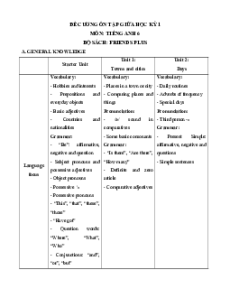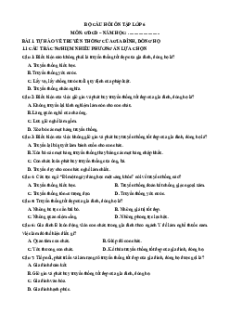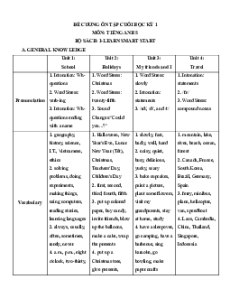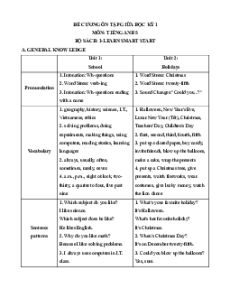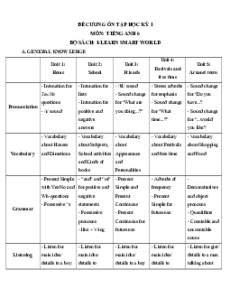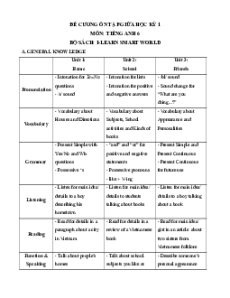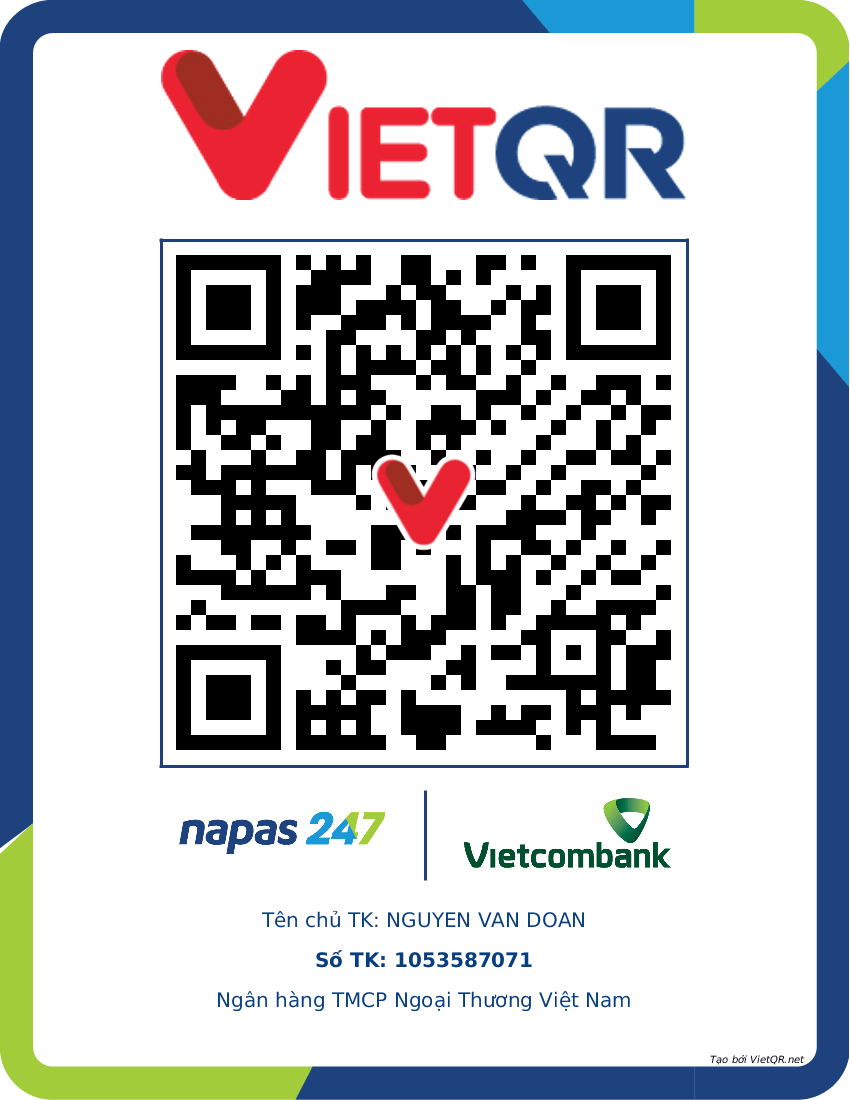Date of planning:…………..
Peroid 87: UNIT 11: OUR GREENER WORLD
Date of teaching: ………..…
Lesson 1: GETTING STARTED WEEK: Let’s go green!
THIS UNIT INCLUDES: Vocabulary Skills:
- Things that can be reduced, reused and
- Reading about ways to go green. recycled
- Talking about tips for going green. Pronunciation:
- Listening about ideas for a green club. - Rhythm in sentences
- Writing a paragraph about ideas for a green club Grammar Everyday English - Articles Giving warnings - First conditional I. OBJECTIVES:
* By the end of this unit, students will be able to:
- use the words for things that can be reduced, reused and recycled;
- say sentences with correct rhythm; - use the articles correctly;
- use the first conditional to talk about possibilities; - give warnings;
- read for general and specific information about ways to go green at school;
- talk about tips for going green;
- listen for details about ideas for a green club;
- write a paragraph about ideas for a green club. 1. Knowledge:
- To introduce topic of the lesson Our greener world . To teach listening and reading about the ways
to do more to protect nature and the environment ‘go green’.
+ Vocabulary: use the words for things that can be reduced, reused and recycled;
- say sentences with correct rhythm; - give warnings;
+ Grammar: - use the articles correctly;
- use the first conditional to talk about possibilities;
2. Competence: Students will be able to pratice reading and listening the conversation between Mi
and Nick talked about ways to go green.
3. Quality/ behavior : The awareness of protecting the environment “go green” (to do more to
protect nature and the environment). Having serious attitude to go green ; Having serious attitude to
working in groups, individual work, cooperative learning and working. II. TEACHING AIDS:
- Teacher: Text book, laptop, louspeaker, projector…
- Students : Text books, studying equipments….
- Work Arrangements: T_Ss , group works; individual …… III. PROCEDURE:
I. WARM UP & INTRODUCTION (5’)
Aims:To create an active atmosphere in the class before the lesson; To lead into the new unit.
* Content: Review the previous lesson or have some warm-up activities to creat a friendly and
relaxed atmostphere to inspire Ss to warm up to the new lesson.
* Outcome: Having a chance to speak English and focus on the topic of the lesson..
* Organisation :Teacher’s instructions…
Teacher’s & Student’s activities Content + Greeting + Greeting
+ Revision. Do the net work/ brainstorming - T_ Ss
- Teacher (T) asks Ss some questions about the + Revision previous lessons, smart TV
- Review the previous unit before Ss open their
books. Write Our houses in the future on the board
and have Ss say all of the words that are related to appliances in this topic. the house
- Write Our Greener World on the board. Ask Ss
what green means to them. Write their answers on
the board. Explain that green has a lot of meanings. wireless TV
In this unit it means relating to the protection of the
environment. Write Let's go green! on the board
and elicit the meaning of go green from Ss. Tell Ss
- (Ss) listen and learn how to do it .
that go green means: to do more to protect nature
and the environment. Have Ss open their books and - Answer the teacher’s questions. start the lesson.
- Open their book and write .
2. PRESENTATION (12’) ACTIVITY 1:
Aims: - To create an active atmosphere in the class before the lesson; - To lead into the new unit.
* Content: Listen and read conversation to get used to the vocabulary; new grammar points.
* Outcome: Reading practice. Ss learn some new words; become familiar with the new language items.
* Organisation : Teacher’s instructions…
1. Listen and read. T_ Ss 1. Listen and read.
*) Pre- teach vocabulary: * Vocabulary
- Teacher uses different techniques to teach - go green means: to do more to protect
nature and the environment.
vocabulary (situation, realia, translation .....)
- reusable (adj) có thể dùng lại
+ Teacher may introduce the vocabulary by:
- go green (v) sống xanh (thân thiện với môi
- providing explanations of the words; trường)
- showing picture illustrating the word.
- recycle (v) tái chế
+ Follow the steps to teach vocabulary
- help (v) giúp đỡ
- Repeat in chorus and individually
- environment (n) môi trường …. + Check vocabulary
* Ask Ss to look at the picture on page 48 - 49 and answer the questions below: 1. Who are they? 2. Where are they?
3. What might they be talking about?
- Quickly write Ss' answers to Question 3 on the board. - Play the recording. - Ss listen and read.
- Ask Ss if their guesses on the board are correct.
- Play the recording twice for Ss to listen and read
along. Have Ss underline the words that are related
to the topic of the unit while listening and reading.
- some pairs of Ss to read the conversation aloud.
- Ss what exactly Mi and Nick talked about. Now
confirm the correct answer. (They talked about - Complete the tasks ways to go green.)
- Have Ss say the words in the text that they
think are related to the topic Our greener world.
- Quickly write the words on one part of the board.
- Get some pairs to read the conversation in front of the class. - Comment on Ss'answers. 3. PRACTICE (18’) ACTIVITY 2:
Aim: To help Ss understand the text in depth.
* Content: Read again the conversation . Complete the sentences . Use no more than 3 words
* Outcome: Ss understand more information in the conversation. Do the filling.
* Organisation : Teacher’s instructions…
2. Read the converstion again. Complete the
2. Read the converstion again. Complete
following sentences. Use no more than three
the following sentences. Use no more than words in each blank.
three words in each blank.
- Ask Ss to work independently to fill each blank - T_ Ss
with the word(s) from the conversation.
- Follow the teacher’s instructions
- Ask them how to do this exercise. T may once
again instruct them how to do the exercise: (1) read - Give the answers and check.
the sentence and identify the kind of information to
fill the blank; (2) read the conversation and locate
the place to find the word(s) to fill the blank.
- Model with the first sentence. * Key:
- Allow Ss to share answers before discussing it as
1. a picnic 2. plastic one 3. the check-out a class.
4. a reusable 5. she's cycling
- Write the correct answers on the board.
- Check the answers as a class. ACTIVITY 3:
Aims: To help Ss understand the text in depth;
- To draw Ss' attention to the first conditional.
* Content: Based on the ideas in the conversation . Pay attention to the first conditional. Matching.
* Outcome: Do the matching to pay attention to the first conditional.
* Organisation : Teacher’s instructions…
3. Based on the ideas in the conversation, match
3. Based on the ideas in the conversation,
the first half of the sentence in column A with its match the first half of the sentence in second half in column B.
column A with its second half in column
- First, ask Ss to read column A and B to make B.
sure they understand. Ask Ss to give their answers - T_ Ss
without reading the conversation again. Then ask - Learn how to do it
them to read the conversation and check their - Share the answers
answers. Confirm the correct answers. - Copy them
- Tell Ss that sentences 2 and 3 are first conditional
Key : 1. b 2. c 3. a
sentences and they will learn about this grammar
point in A CLOSER LOOK 2.
- Write the correct answers on the board. - T gives correct answer. ACTIVITY 4:
Aim: To develop Ss' knowledge of the vocabulary for how to help the environment.
* Content: Do the matching. Learn the vocabulary for how to help the environment.
* Outcome: Ss have knowledge of the vocabulary for how to help the environment. Matching.
* Organisation : Teacher’s instructions…
4. Match the pictures with the ways to help the
4. Match the pictures with the ways to environment. help the environment.
- Have Ss look at the pictures and discuss what they - T_ Ss
can see in each picture in pairs. Invite some pairs to - Ss do the tasks
share their answers with the whole class.
- Ss do themselves. Give the answers
Ask Ss to match the pictures with ways to help the
environment. Have some Ss share their answers. Confirm the correct answers.
Key : 1. c 2. a 3. b 4. e 5. d
Ask Ss to add any other ways to save the environment they know.
- Check the answers as a class. 4. PRODUCTION (8’) ACTIVITY 5:
Aim: To provide Ss with an opportunity to communicate with each other, using the vocabulary they have learnt.
* Content: Play GAME find someone who…. Ask and answer .
* Outcome: Ss can ask and answer the questions . Take note . Report infront of the class.
* Organisation : Teacher’s instructions…
Giáo án Unit 11: Our greener world Tiếng Anh 6 Global success
869
435 lượt tải
MUA NGAY ĐỂ XEM TOÀN BỘ TÀI LIỆU
CÁCH MUA:
- B1: Gửi phí vào TK:
1133836868- CT TNHH DAU TU VA DV GD VIETJACK - Ngân hàng MB (QR) - B2: Nhắn tin tới Zalo VietJack Official ( nhấn vào đây ) để xác nhận thanh toán và tải tài liệu - giáo án
Liên hệ ngay Hotline hỗ trợ: 084 283 45 85
Bộ giáo án Tiếng anh 6 Global success được cập nhật liên tục trong gói này từ nay đến hết tháng 3/2024.
Để tải tài liệu gốc về máy bạn click vào nút Tải Xuống ở trên!
Thuộc bộ (mua theo bộ để tiết kiệm hơn):
- Bộ giáo án Tiếng anh 6 Global success năm 2023 mới, chuẩn nhất được thiết kế theo phong cách hiện đại, đẹp mắt, trình bày chi tiết cho từng bài học và bám sát chương trình Sách giáo khoa Tiếng anh 6 Global success.
- Mua trọn bộ sẽ tiết kiệm hơn tải lẻ 50%.
Đánh giá
4.6 / 5(869 )5
4
3
2
1
Trọng Bình
Tài liệu hay
Giúp ích cho tôi rất nhiều
Duy Trần
Tài liệu chuẩn
Rất thích tài liệu bên VJ soạn (bám sát chương trình dạy)
TÀI LIỆU BỘ BÁN CHẠY MÔN Tiếng Anh
Xem thêmTÀI LIỆU BỘ BÁN CHẠY Lớp 6
Xem thêmTài liệu bộ mới nhất

Date of planning:…………..
Date of teaching: ………..…
WEEK:
Peroid 87: UNIT 11: OUR GREENER WORLD
Lesson 1: GETTING STARTED
Let’s go green!
THIS UNIT INCLUDES:
Vocabulary
- Things that can be reduced, reused and
recycled
Pronunciation:
- Rhythm in sentences
Grammar
- Articles
- First conditional
Skills:
- Reading about ways to go green.
- Talking about tips for going green.
- Listening about ideas for a green club.
- Writing a paragraph about ideas for a green club
Everyday English
Giving warnings
I. OBJECTIVES:
* By the end of this unit, students will be able to:
- use the words for things that can be reduced, reused and recycled;
- say sentences with correct rhythm;
- use the articles correctly;
- use the first conditional to talk about possibilities;
- give warnings;
- read for general and specific information about ways to go green at school;
- talk about tips for going green;
- listen for details about ideas for a green club;
- write a paragraph about ideas for a green club.
1. Knowledge:
- To introduce topic of the lesson Our greener world . To teach listening and reading about the ways
to do more to protect nature and the environment ‘go green’.
+ Vocabulary: use the words for things that can be reduced, reused and recycled;
- say sentences with correct rhythm;
- give warnings;
+ Grammar: - use the articles correctly;
- use the first conditional to talk about possibilities;
2. Competence: Students will be able to pratice reading and listening the conversation between Mi
and Nick talked about ways to go green.
3. Quality/ behavior : The awareness of protecting the environment “go green” (to do more to
protect nature and the environment). Having serious attitude to go green ; Having serious attitude to
working in groups, individual work, cooperative learning and working.
II. TEACHING AIDS:
- Teacher: Text book, laptop, louspeaker, projector…
- Students : Text books, studying equipments….
- Work Arrangements: T_Ss , group works; individual ……
III. PROCEDURE:
I. WARM UP & INTRODUCTION (5’)

Aims:To create an active atmosphere in the class before the lesson;
To lead into the new unit.
* Content: Review the previous lesson or have some warm-up activities to creat a friendly and
relaxed atmostphere to inspire Ss to warm up to the new lesson.
* Outcome: Having a chance to speak English and focus on the topic of the lesson..
* Organisation :Teacher’s instructions…
Teacher’s & Student’s activities
Content
+ Greeting
+ Revision. Do the net work/ brainstorming
- Teacher (T) asks Ss some questions about the
previous lessons,
- Review the previous unit before Ss open their
books. Write Our houses in the future on the board
and have Ss say all of the words that are related to
this topic.
- Write Our Greener World on the board. Ask Ss
what green means to them. Write their answers on
the board. Explain that green has a lot of meanings.
In this unit it means relating to the protection of the
environment. Write Let's go green! on the board
and elicit the meaning of go green from Ss. Tell Ss
that go green means: to do more to protect nature
and the environment. Have Ss open their books and
start the lesson.
+ Greeting
- T_ Ss
+ Revision
- (Ss) listen and learn how to do it .
- Answer the teacher’s questions.
- Open their book and write .
2. PRESENTATION (12’)
ACTIVITY 1:
Aims: - To create an active atmosphere in the class before the lesson;
- To lead into the new unit.
* Content: Listen and read conversation to get used to the vocabulary; new grammar points.
* Outcome: Reading practice. Ss learn some new words; become familiar with the new language
items.
* Organisation : Teacher’s instructions…
1. Listen and read. T_ Ss
*) Pre- teach vocabulary:
- Teacher uses different techniques to teach
vocabulary (situation, realia, translation .....)
+ Teacher may introduce the vocabulary by:
- providing explanations of the words;
- showing picture illustrating the word.
+ Follow the steps to teach vocabulary
- Repeat in chorus and individually
+ Check vocabulary
* Ask Ss to look at the picture on page 48 - 49 and
1. Listen and read.
* Vocabulary
- go green means: to do more to protect
nature and the environment.
- reusable (adj) có thể dùng lại
- go green (v) sống xanh (thân thiện với môi
trường)
- recycle (v) tái chế
- help (v) giúp đỡ
- environment (n) môi trường ….
appliances in
the house
smart TV
wireless TV

answer the questions below:
1. Who are they?
2. Where are they?
3. What might they be talking about?
- Quickly write Ss' answers to Question 3 on the
board.
- Play the recording.
- Ss listen and read.
- Ask Ss if their guesses on the board are correct.
- Play the recording twice for Ss to listen and read
along. Have Ss underline the words that are related
to the topic of the unit while listening and reading.
- some pairs of Ss to read the conversation aloud.
- Ss what exactly Mi and Nick talked about. Now
confirm the correct answer. (They talked about
ways to go green.)
- Have Ss say the words in the text that they
think are related to the topic Our greener world.
- Quickly write the words on one part of the board.
- Get some pairs to read the conversation in front of
the class.
- Comment on Ss'answers.
- Complete the tasks
3. PRACTICE (18’)
ACTIVITY 2:
Aim: To help Ss understand the text in depth.
* Content: Read again the conversation . Complete the sentences . Use no more than 3 words
* Outcome: Ss understand more information in the conversation. Do the filling.
* Organisation : Teacher’s instructions…
2. Read the converstion again. Complete the
following sentences. Use no more than three
words in each blank.
- Ask Ss to work independently to fill each blank
with the word(s) from the conversation.
- Ask them how to do this exercise. T may once
again instruct them how to do the exercise: (1) read
the sentence and identify the kind of information to
fill the blank; (2) read the conversation and locate
the place to find the word(s) to fill the blank.
- Model with the first sentence.
- Allow Ss to share answers before discussing it as
a class.
- Write the correct answers on the board.
- Check the answers as a class.
2. Read the converstion again. Complete
the following sentences. Use no more than
three words in each blank.
- T_ Ss
- Follow the teacher’s instructions
- Give the answers and check.
* Key:
1. a picnic 2. plastic one 3. the check-out
4. a reusable 5. she's cycling
ACTIVITY 3:

Aims: To help Ss understand the text in depth;
- To draw Ss' attention to the first conditional.
* Content: Based on the ideas in the conversation . Pay attention to the first conditional. Matching.
* Outcome: Do the matching to pay attention to the first conditional.
* Organisation : Teacher’s instructions…
3. Based on the ideas in the conversation, match
the first half of the sentence in column A with its
second half in column B.
- First, ask Ss to read column A and B to make
sure they understand. Ask Ss to give their answers
without reading the conversation again. Then ask
them to read the conversation and check their
answers. Confirm the correct answers.
- Tell Ss that sentences 2 and 3 are first conditional
sentences and they will learn about this grammar
point in A CLOSER LOOK 2.
- Write the correct answers on the board.
- T gives correct answer.
3. Based on the ideas in the conversation,
match the first half of the sentence in
column A with its second half in column
B.
- T_ Ss
- Learn how to do it
- Share the answers
- Copy them
Key : 1. b 2. c 3. a
ACTIVITY 4:
Aim: To develop Ss' knowledge of the vocabulary for how to help the environment.
* Content: Do the matching. Learn the vocabulary for how to help the environment.
* Outcome: Ss have knowledge of the vocabulary for how to help the environment. Matching.
* Organisation : Teacher’s instructions…
4. Match the pictures with the ways to help the
environment.
- Have Ss look at the pictures and discuss what they
can see in each picture in pairs. Invite some pairs to
share their answers with the whole class.
Ask Ss to match the pictures with ways to help the
environment. Have some Ss share their answers.
Confirm the correct answers.
Ask Ss to add any other ways to save the
environment they know.
- Check the answers as a class.
4. Match the pictures with the ways to
help the environment.
- T_ Ss
- Ss do the tasks
- Ss do themselves. Give the answers
Key : 1. c 2. a 3. b 4. e 5. d
4. PRODUCTION (8’)
ACTIVITY 5:
Aim: To provide Ss with an opportunity to communicate with each other, using the
vocabulary they have learnt.
* Content: Play GAME find someone who…. Ask and answer .
* Outcome: Ss can ask and answer the questions . Take note . Report infront of the class.
* Organisation : Teacher’s instructions…

5. GAME. Find some one who… . Work in
groups. ask and answer to find some one who
does the things in 4.
- Ask Ss to work in groups. Give each group a
handout with the following table:
- Model the way to ask questions and answers with
a student (e.g. Nam, do you use reusable bags?,
etc.).
- Ask each group to choose one student to ask the
questions and another student to record the answers
and report the results.
- Give Ss 5 - 7 minutes to ask and answer In
groups.
- Move around to observe and offer help.
- Invite Ss to share their findings to the class.
5. GAME. Find some one who… . Work
in groups. ask and answer to find some
one who does the things in 4.
- Work in groups
Find someone who ...
Names
uses reusable bags
cycles
walks to school
picks up rubbish
plants trees
- Do the tasks
5 . WRAP-UP & HOME WORK (2’)
*Ask one or two Ss to tell the class what they have learnt.
- Ask Ss to say some words they remember from the lesson.
*HOME WORK
- Read again the conversation on page 48
- Do more exercises in workbook.
- Prepare new lessons
=========================
